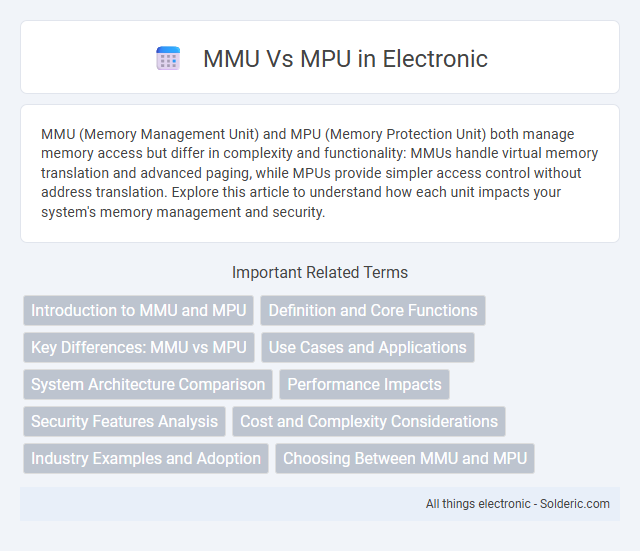MMU (Memory Management Unit) and MPU (Memory Protection Unit) both manage memory access but differ in complexity and functionality: MMUs handle virtual memory translation and advanced paging, while MPUs provide simpler access control without address translation. Explore this article to understand how each unit impacts your system's memory management and security.
Comparison Table
| Feature | MMU (Memory Management Unit) | MPU (Memory Protection Unit) |
|---|---|---|
| Primary Function | Manages virtual memory and address translation | Controls access permissions without virtual memory |
| Memory Type | Supports virtual memory with paging and segmentation | Works with physical memory regions only |
| Protection Scope | Provides fine-grained memory protection and isolation | Offers basic region-based access control |
| Complexity | Complex, supports dynamic memory management | Simpler, static configuration of memory regions |
| Typical Use Cases | Operating systems, multitasking environments | Embedded systems, microcontrollers |
| Address Translation | Translates virtual to physical addresses | No address translation, uses physical addresses |
| Hardware Overhead | Higher due to page tables and TLB requirements | Lower, minimal hardware support needed |
Introduction to MMU and MPU
The Memory Management Unit (MMU) and Memory Protection Unit (MPU) are critical hardware components in computer architecture managing memory access and protection. MMUs enable virtual memory implementation, translating virtual addresses to physical addresses, supporting features like paging and segmentation for complex operating systems. MPUs provide simpler memory protection by defining memory regions with specific access permissions, primarily used in embedded systems for enhancing security without full virtual memory support.
Definition and Core Functions
A Memory Management Unit (MMU) is a hardware component responsible for translating virtual memory addresses to physical addresses and managing memory protection and access control. The Memory Protection Unit (MPU) provides memory region access permissions but does not support virtual memory address translation, making it simpler and more predictable for real-time systems. Understanding the differences between MMU and MPU helps you select the right memory management technology based on your system's complexity and performance requirements.
Key Differences: MMU vs MPU
Memory Management Units (MMUs) and Memory Protection Units (MPUs) differ primarily in complexity and functionality; MMUs provide full virtual memory support with address translation and paging, while MPUs offer basic memory protection without virtual memory. MMUs enable sophisticated features like multitasking, process isolation, and dynamic memory allocation, whereas MPUs focus on setting fixed memory region permissions to prevent unauthorized access. The choice between MMU and MPU depends on system requirements for memory management sophistication and resource constraints.
Use Cases and Applications
MMUs (Memory Management Units) are essential in complex operating systems, enabling virtual memory support, multitasking, and memory protection for applications like Windows, Linux, and Android. MPUs (Memory Protection Units) are used in resource-constrained embedded systems and real-time operating systems, providing memory region protection without full virtual memory, ideal for microcontrollers in automotive, industrial control, and IoT devices. Your choice between MMU and MPU depends on whether your application demands advanced memory management and multitasking or lightweight, deterministic memory protection.
System Architecture Comparison
A Memory Management Unit (MMU) supports complex virtual memory systems by translating virtual addresses to physical addresses, enabling features like paging and segmentation for advanced multitasking and process isolation. In contrast, a Memory Protection Unit (MPU) provides simpler memory protection by defining fixed memory regions with access permissions, lacking address translation capabilities. System architectures utilizing MMUs are typically found in general-purpose operating systems requiring robust memory management, whereas MPUs are favored in embedded systems prioritizing real-time performance and low overhead.
Performance Impacts
MMU (Memory Management Unit) enhances performance by enabling efficient virtual memory management, reducing page faults, and supporting advanced features like caching and memory protection. MPU (Memory Protection Unit) offers simpler protection with low overhead but lacks virtual memory support, potentially limiting multitasking efficiency and scalability. Your system's performance may benefit more from an MMU when handling complex applications or multitasking demands.
Security Features Analysis
Memory Management Units (MMUs) provide advanced security features such as virtual memory isolation, access permission controls, and address translation, which prevent unauthorized access and protect against buffer overflow attacks. In contrast, Memory Protection Units (MPUs) offer basic region-based access control with limited granularity, making them suitable for simpler security requirements but less robust against complex threats. MMUs enhance security by supporting multiple privilege levels and fine-grained memory segmentation, critical for modern operating systems and application isolation.
Cost and Complexity Considerations
MPUs typically have lower hardware costs and simpler designs compared to MMUs, making them ideal for cost-sensitive applications with basic memory protection needs. MMUs add complexity with features like virtual memory management and advanced address translation, increasing both design effort and manufacturing expense. Your choice depends on balancing required functionality against budget constraints and system complexity.
Industry Examples and Adoption
MMUs are widely adopted in industries requiring advanced virtual memory management and process isolation, such as desktop computing, servers, and high-performance embedded systems like automotive infotainment and medical devices. MPUs are prevalent in safety-critical and real-time applications found in aerospace, industrial automation, and microcontroller-based IoT devices where deterministic memory protection is necessary without the overhead of virtual memory. Your choice between MMU and MPU depends on whether complex memory virtualization or simple access control is prioritized in the industry context.
Choosing Between MMU and MPU
Choosing between an MMU (Memory Management Unit) and an MPU (Memory Protection Unit) depends on your system's complexity and application requirements. MMUs offer comprehensive virtual memory management, ideal for operating systems needing advanced features like paging and swapping, while MPUs provide simpler memory protection suited for real-time and embedded systems. Your decision hinges on balancing the need for sophisticated memory handling against resource constraints and real-time performance.
MMU vs MPU Infographic

 solderic.com
solderic.com